Solar eclipse of February 26, 1998
A total solar eclipse occurred on February 26, 1998. A solar eclipse occurs when the Moon passes between Earth and the Sun, thereby totally or partly obscuring the image of the Sun for a viewer on Earth. A total solar eclipse occurs when the Moon's apparent diameter is larger than the Sun's, blocking all direct sunlight, turning day into darkness. Totality occurs in a narrow path across Earth's surface, with the partial solar eclipse visible over a surrounding region thousands of kilometres wide. Totality was visible in Galápagos Islands, Panama, Colombia, northwestern Venezuela, the whole Aruba, most part of Curaçao and the northwestern tip of Bonaire (belonging to Netherlands Antilles which dissolved later), the whole Montserrat, Guadeloupe and Antigua and Barbuda.
| Solar eclipse of February 26, 1998 | |
|---|---|
 Map | |
| Type of eclipse | |
| Nature | Total |
| Gamma | 0.2391 |
| Magnitude | 1.0441 |
| Maximum eclipse | |
| Duration | 249 sec (4 m 9 s) |
| Coordinates | 4.7°N 82.7°W |
| Max. width of band | 151 km (94 mi) |
| Times (UTC) | |
| Greatest eclipse | 17:29:27 |
| References | |
| Saros | 130 (51 of 73) |
| Catalog # (SE5000) | 9503 |
In popular culture
The 2001 Japanese film Orozco the Embalmer briefly featured the total eclipse as seen from Colombia.
Images
.jpg)
Related eclipses
Eclipses of 1998
- A total solar eclipse on February 26.
- A penumbral lunar eclipse on March 13.
- A penumbral lunar eclipse on August 8.
- An annular solar eclipse on August 22.
- A penumbral lunar eclipse on September 6.
Solar eclipses 1997–2000
This eclipse is a member of a semester series. An eclipse in a semester series of solar eclipses repeats approximately every 177 days and 4 hours (a semester) at alternating nodes of the Moon's orbit.[1]
| Solar eclipse series sets from 1997–2000 | ||||||
|---|---|---|---|---|---|---|
| Descending node | Ascending node | |||||
| Saros | Map | Gamma | Saros | Map | Gamma | |
120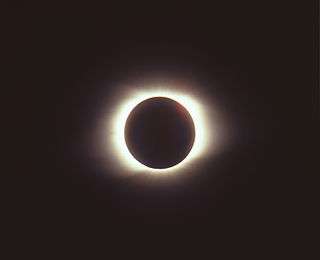 Chita, Russia | 1997 March 9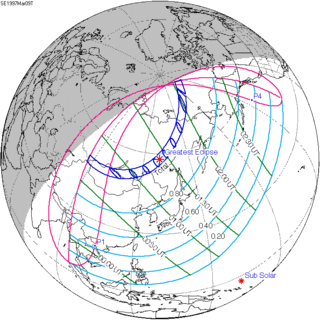 Total | 0.91830 | 125 | 1997 September 2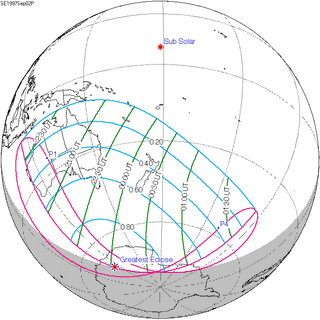 Partial | -1.03521 | |
130.jpg) Total eclipse near Guadelope | 1998 February 26 Total | 0.23909 | 135 | 1998 August 22 Annular | -0.26441 | |
| 140 | 1999 February 16 Annular | -0.47260 | 145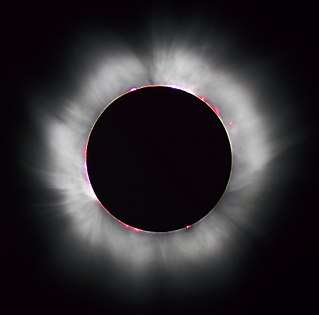 Totality from France | 1999 August 11 Total | 0.50623 | |
| 150 | 2000 February 5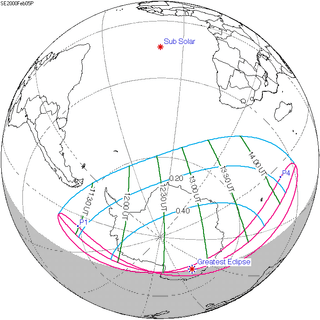 Partial | -1.22325 | 155 | 2000 July 31 Partial | 1.21664 | |
| Partial solar eclipses on July 1, 2000 and December 25, 2000 occur in the next lunar year eclipse set. | ||||||
Saros 130
This eclipse is a part of Saros cycle 130, repeating every 18 years, 11 days, containing 73 events. The series started with partial solar eclipse on August 20, 1096. It contains total eclipses from April 5, 1475 through July 18, 2232. There are no annular eclipses in the series. The series ends at member 73 as a partial eclipse on October 25, 2394. The longest duration of totality was 6 minutes, 41 seconds on July 11, 1619. All eclipses in this series occurs at the Moon’s descending node.[2]
| Series members 43–56 between 1853 and 2300 | ||
|---|---|---|
| 43 | 44 | 45 |
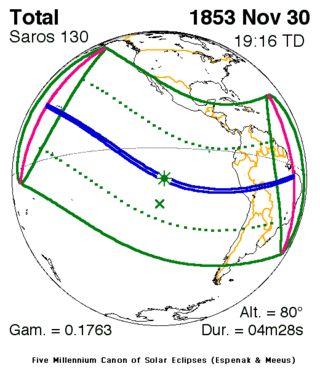 November 30, 1853 |
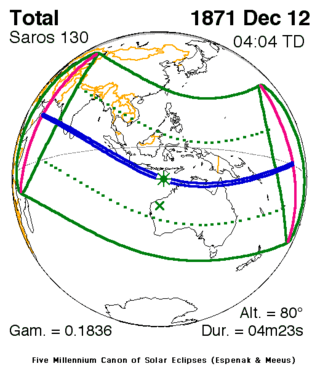 December 12, 1871 |
 December 22, 1889 |
| 46 | 47 | 48 |
 January 3, 1908 |
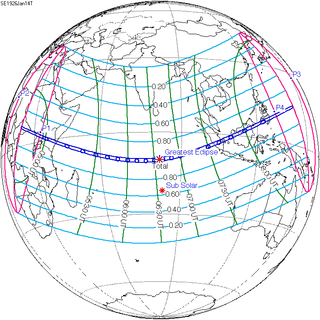 January 14, 1926 |
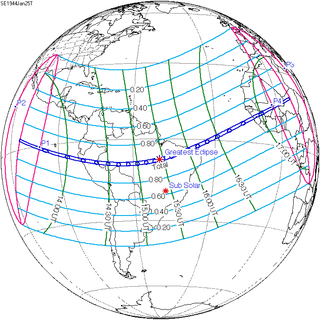 January 25, 1944 |
| 49 | 50 | 51 |
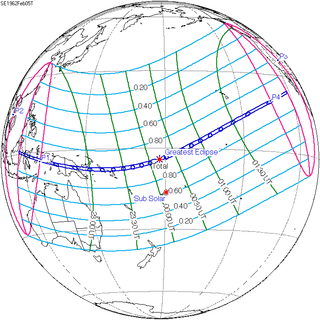 February 5, 1962 |
 February 16, 1980 |
 February 26, 1998 |
| 52 | 53 | 54 |
 March 9, 2016 |
 March 20, 2034 |
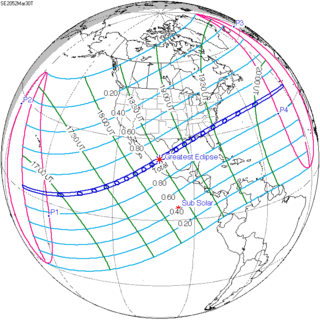 March 30, 2052 |
| 55 | 56 | 57 |
 April 11, 2070 |
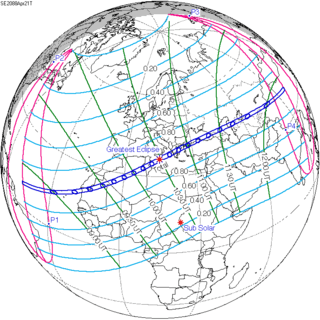 April 21, 2088 |
 May 3, 2106 |
| 58 | 59 | 60 |
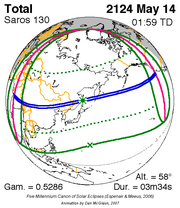 May 14, 2124 |
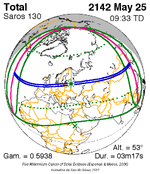 May 25, 2142 |
 June 4, 2160 |
| 61 | 62 | 63 |
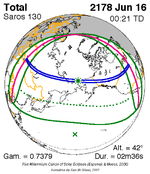 June 16, 2178 |
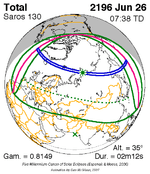 June 26, 2196 |
 July 8, 2214 |
| 64 | 65 | 66 |
 July 18, 2232 |
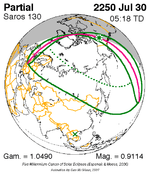 July 30, 2250 |
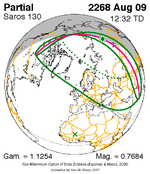 August 9, 2268 |
| 67 | ||
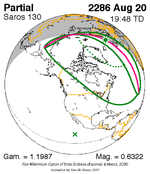 August 20, 2286 | ||
Metonic cycle
The metonic series repeats eclipses every 19 years (6939.69 days), lasting about 5 cycles. Eclipses occur in nearly the same calendar date. In addition, the octon subseries repeats 1/5 of that or every 3.8 years (1387.94 days). All eclipses in this table occur at the Moon's descending node.
| 21 events between July 22, 1971 and July 22, 2047 | ||||
|---|---|---|---|---|
| July 21–22 | May 9–11 | February 26–27 | December 14–15 | October 2–3 |
| 106 | 108 | 110 | 112 | 114 |
| July 21, 1952 | May 10, 1956 | February 26, 1960 | December 16, 1963 | October 3, 1967 |
| 116 | 118 | 120 | 122 | 124 |
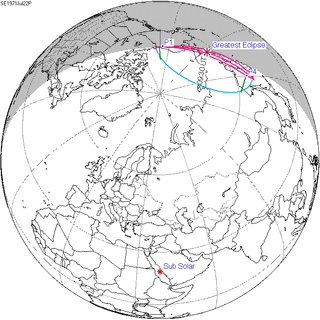 July 22, 1971 |
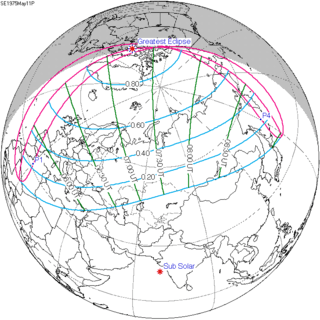 May 11, 1975 |
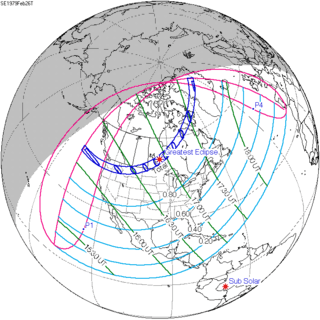 February 26, 1979 |
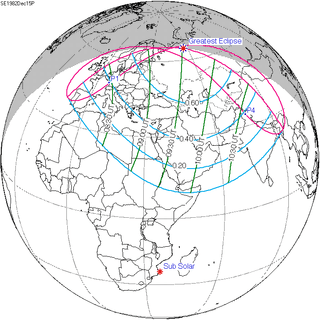 December 15, 1982 |
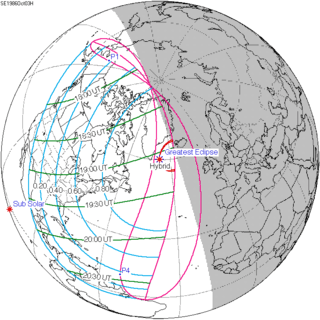 October 3, 1986 |
| 126 | 128 | 130 | 132 | 134 |
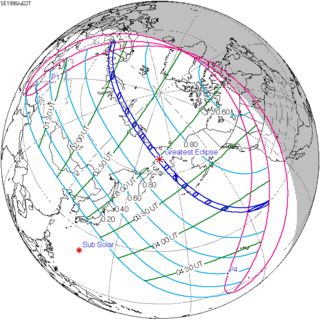 July 22, 1990 |
 May 10, 1994 |
 February 26, 1998 |
 December 14, 2001 |
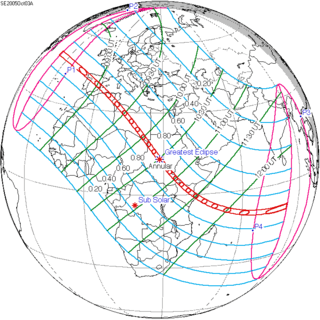 October 3, 2005 |
| 136 | 138 | 140 | 142 | 144 |
 July 22, 2009 |
 May 10, 2013 |
 February 26, 2017 |
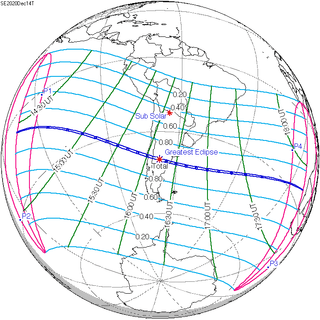 December 14, 2020 |
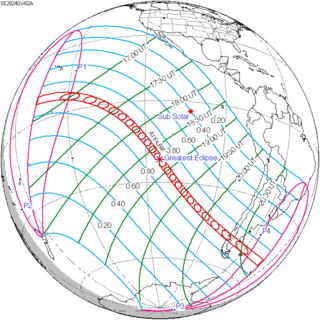 October 2, 2024 |
| 146 | 148 | 150 | 152 | 154 |
 July 22, 2028 |
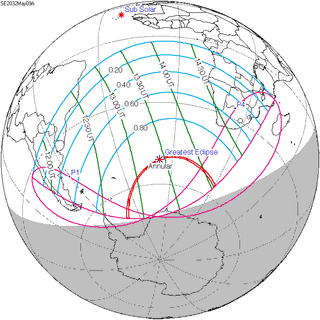 May 9, 2032 |
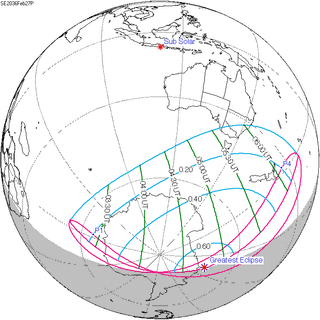 February 27, 2036 |
 December 15, 2039 |
 October 3, 2043 |
| 156 | ||||
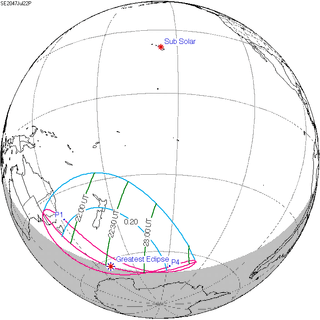 July 22, 2047 | ||||
Notes
- van Gent, R.H. "Solar- and Lunar-Eclipse Predictions from Antiquity to the Present". A Catalogue of Eclipse Cycles. Utrecht University. Retrieved 6 October 2018.
- "Saros Series catalog of solar eclipses". NASA.
References
- Earth visibility chart and eclipse statistics Eclipse Predictions by Fred Espenak, NASA/GSFC
External links
Sites and Photos
- Venezuela. Prof. Druckmüller's eclipse photography site
- Aruba. Prof. Druckmüller's eclipse photography site
- Solar Corona Shape
- APOD 3/11/1998, A Total Eclipse of the Sun, totality from Venezuela.
- APOD 3/12/1998, Moon Shadow satellite animation, 2/1998.
- The 1998 Eclipse in Venezuela
Videos
- Total eclipse, 1998 February 26, Venezuela
- Aruba Eclipse - February 26, 1998
- Maracaibo eclipse solar 1998
| Wikimedia Commons has media related to Solar eclipse of 1998 February 26. |
.jpg)
